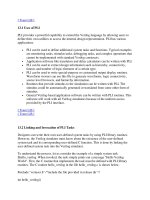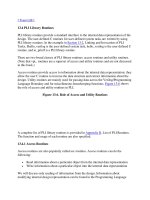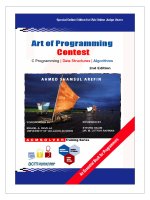Programming language (Types of highlevel language)
Bạn đang xem bản rút gọn của tài liệu. Xem và tải ngay bản đầy đủ của tài liệu tại đây (3.32 MB, 66 trang )
Types of high-level
language
Contents
1. Procedural Language
2. Non-procedural Language
3. Object-oriented Language
1. Procedural Language
1.1. What is procedural language?
A procedural language is a type of
computer programming language that
specifies a series of well-structured
steps and procedures within its
programming context to compose a
program.
1. Procedural Language
1.1. What is procedural language?
Main Program
Function 1
Function 2
Function 3
Function 4
Function 5
1. Procedural Language
1.2. Examples
1. Procedural Language
1.3. Advantages
• The ability to re-use the same code at different places
in the program without copying it.
• An easier way to keep track of program flow.
• The ability to be strongly modular or structured.
• Needs only less memory.
1. Procedural Language
1.4. Disadvantages
• Data is exposed to whole program -> No security for data
• Difficult to relate with real world objects.
• Difficult to create new data types -> Less extensibility
• Importance is given to the operation on data rather than the
data.
2. Non-procedural Language
2.1. What is non-procedural language?
Non-procedural language, also known
as application language or functional
language, deals with developing
functions from other functions to build
more complex functions
2. Non-procedural Language
2.1. What is non-procedural language?
1. Non-procedural Language
1.2. Examples
2. Non-procedural Language
2.3. Advantages
• Easy to write large program
• Easy to understand.
• The execution time is very fast.
2. Non-procedural Language
2.4. Disadvantages
• It is not very flexible.
• For the large program, the code will
become very complex
• The syntax of this language is not
very easy.
3. Object-Oriented Language
3.1. What is Object-Oriented Language?
Object-Oriented Language is a
programing language in which
programs are written and structured
around objects rather than functions or
logic.
3. Object-Oriented Language
Methods
3.1. What is Object-Oriented Language?
Object
Object
Data
Data
Function
Function
Function
Function
3. Object-Oriented Language
3.2. Examples
3. Object-Oriented Language
3.3. Advantages
• A real-world idea can be demonstrated
• Programs are easier to test and
maintain.
• Faster development of code
• OOP provides greater security due to
data abstraction.
3. Object-Oriented Language
3.4. Disadvantages
• Designing a program with an OOP concept can be tricky.
• A programmer needs to plan beforehand for developing a
program
• The size of programs developed with OOP is bigger than
procedural approach.
• The execution time for these programs is also more.
Introduction to
some high-level
laguages
4.1
C
Programming
language
C Language
- Developed by Bell Laboratories
in the early 1970s.
- C is a procedural programming
language
- Often used for system programs.
- Unix is written in C.
2
0
How does C programming language work?
How does C programming
language work?
▹ C is a compiled language. A compiler is
a special tool that compiles the program
and converts it into the object file which
is machine readable.
▹ After the compilation process, the linker
will combine different object files and
creates a single executable file to run
the program.
2
2
Example of C
Key Applications
▹
▹
▹
▹
▹
▹
‘C’ language is widely used in
embedded systems.
Developing system applications.
Developing desktop applications.
Used for developing browsers and their
extensions.
Used to develop databases.
Used in IOT applications.
2
4
Advantages of C
• The code written in C language is Simple to write and
understand.
• The execution time is super-fast compared to other
programming languages.
• It is convenient to develop an application that falls in the
high.
• C is an excellent choice for implementing algorithms and
data structures.
• With the help of the C language, it is easy to develop system
software and operating system.









